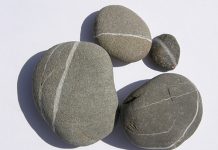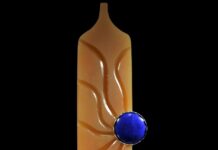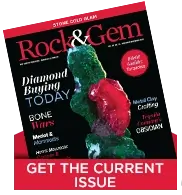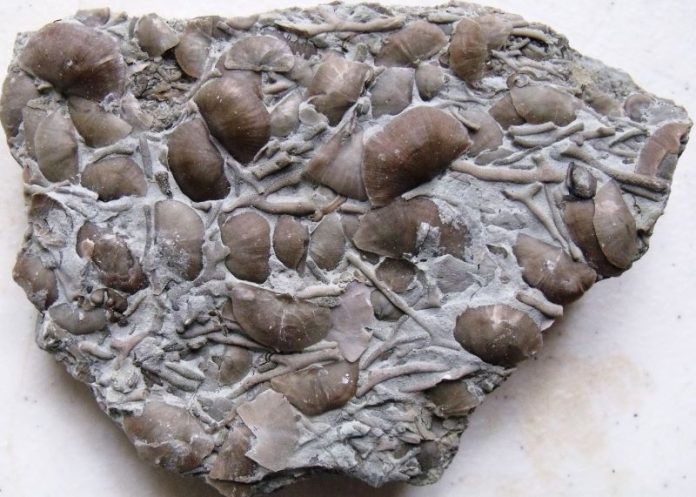
St. Leon, Indiana fossils are scattered across the ground, just waiting to be picked up and admired. Imagine walking through an area filled with millions of ancient treasures, ready for your bucket list. I’ve visited this spot many times, and each trip brings something new and exciting. This time, the moment I stepped out of the car and onto the embankment, I spotted the largest and best-preserved Rafinesquina ponderosa shell I’ve ever found at the site.
Fossil Hunting at St. Leon, Indiana
St. Leon in southern Indiana is a must-see for fossil collectors of ancient marine creatures. It is readily accessible off U.S. 74 at exit 164, not far from the border of Ohio. The area around St. Leon was formed during the Ordovician Period (the second period of the Paleozoic, some 485 – 443 million years ago) when it was a warm, shallow salt-water sea teaming with life. Horn corals and bryozoans began the formation of coral reefs, allowing other creatures, such as trilobites, to hide from predators. Ocean sediments were deposited during this period and often contained large amounts of fauna. Much of the sediment today is comprised of layers of shale mixed with layers of fossiliferous limestone. The shale was formed from sediments deposited by large-scale storms. These storms also hit land masses, supplying an outwash of sediment, aiding in the burial of the creatures. The shale it produced preserved the creatures in outstanding detail.
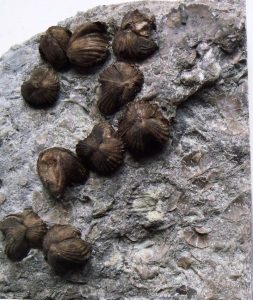 Best Places to Collect Fossils Near St. Leon
Best Places to Collect Fossils Near St. Leon
The collecting area is just north of St. Leon. After taking exit 164, head north on Route 1. Several miles ahead, on both sides of the road, are high embankments to the left and right. These locations were once at the bottom of a saltwater tropical sea. Parking along the road is allowed and there is a wide shoulder strip that allows visitors to get safely off the main highway.
No tools are allowed and no digging is allowed. As soon as you exit the car and look at the embankment, you will begin to see fossils and slabs of fossil “hash,” which are the remains of many invertebrates cemented together in slabs.
The sides of the embankment are steep in most areas, so extra caution should be taken when ascending the embankment. Slabs of shell hash litter make it difficult at times to climb up.
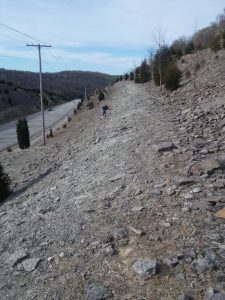 What Fossil Hash Reveals About Ancient Seas
What Fossil Hash Reveals About Ancient Seas
Hash litter contains the remains of seashells of different kinds. One of the largest is the Rafinesquina ponderosa. The thin shell has a convex top and a concave bottom. Other shells include Hiscobeccus capex and Platystrophia. Fossil horn corals called Grewinka canadensis are also found, though not as commonly.
Trilobites, though not common, are also found mostly on the western slope. They are generally small and in an enrolled condition. Flexicalymene trilobites are common in southern Ohio and Indiana. The Isotelus maximus trilobite can also be found, though only as bits and pieces of external molted carapace or exoskeleton.
You may also find pockets of Hiscobeccus brachiopods out of the matrix.
One trick to finding some nice, smaller, but complete, fossils is to flip over some of the larger hash plates and look underneath.
St. Leon, Indiana Fossils: Planning Your Visit
This is an area where one could spend days, maybe weeks, exploring. There are plenty of St. Leon, Indiana fossils for everyone. I plan on returning time and again to collect and explore. Please leave the area as you find it. Pack in and pack out your trash. Let’s follow the rules so this site remains open to the public for future generations.
This story about St. Leon, Indiana fossils appeared in Rock & Gem magazine. Click here to subscribe. Story and photos by Joseph J. “PaleoJoe” Kchodl.









